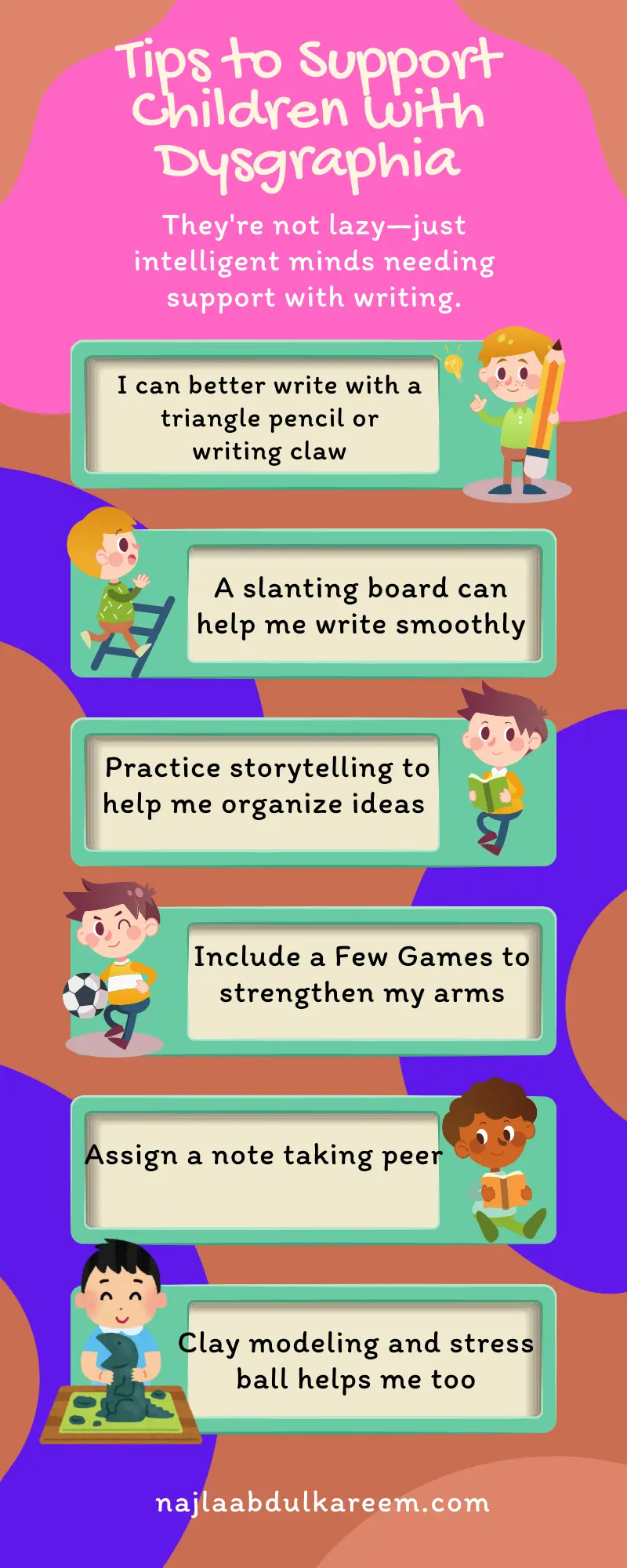Dysgraphia is a neurological learning disability that affects writing skills. If not properly assessed, it can lead to challenges later in a child’s academic life, especially for those with autism spectrum disorder (ASD).
I am here to walk you through the different perspectives on this topic, from the writing challenges in children, and the emotional stress they face to practical strategies that parents and caregivers can offer to support children with dysgraphia, using real-life examples and expert advice.

Image:Freepik
What is Dysgraphia? Understanding Writing Challenges in Children
Dysgraphia is a neurological condition that affects writing abilities. Fine motor issues, such as difficulty in handwriting, spelling, and copying notes, often result from this condition. Dysgraphia is not a sign of low intelligence; rather, this condition occurs when the brain struggles to process and execute writing tasks.
Dysgraphia and Autism
Although dysgraphia is often associated with autism spectrum disorder (ASD), the two are distinct conditions. ASD is a neurodevelopmental disorder that affects social communication and behavior, whereas dysgraphia is a neurological learning disability that impairs writing abilities.
The overlap occurs frequently because both conditions can present difficulties with motor coordination and language processing. Recognizing this link can assist parents and teachers in developing personalized strategies to address writing difficulties in children with ASD.
How is Dysgraphia Diagnosed?
No medical test is required or available to diagnose dysgraphia. Instead, healthcare providers carefully evaluate your child’s writing difficulties before diagnosis.
You can determine your child’s writing speed and legibility through these tests:
Formalized handwriting assessments: These tests can help you determine how fast and legible your child writes.
Beery’s Developmental Test of Visuomotor Integration (VMI): This test assesses your child’s ability to integrate visual and motor skills, which are required for writing.
The Emotional Toll of Dysgraphia on Children: Looking Beyond Handwriting Struggles
During an interview with a consultant psychologist, Nihma Razak explained her personal experience from her training period that pointed to the emotional difficulties associated with dysgraphia.
She worked with a teenager who seemed completely fine, except for problems with writing. In his teens, his writing struggles started to affect his mental and physical health. Eventually, he was diagnosed with ASD (Autism Spectrum Disorder). To avoid the stress of writing, he often chose to sleep for long hours instead. She also mentioned that the boy was very quiet, and since he didn’t cause any disruptions in class, teachers never investigated the underlying issue.
Breaking Misconceptions: Challenging the Stereotypes of Dysgraphia
Beyond the emotional toll dysgraphia takes on children, societal misconceptions often add to their burden. Mislabeling children as lazy or unmotivated can overshadow their true struggles. To better understand and support children with dysgraphia, it’s important to challenge some common stereotypes:
-
- Struggling with writing doesn’t mean a lack of intelligence. Many children who face writing challenges excel in other areas, showcasing their unique talents and abilities.
- Coping behaviors, like refusal to write or procrastination, are often rooted in frustration. These actions should not be seen as defiance but as signs of the child’s inner struggles with the task.
Recognizing these behaviors as cries for help allows parents and teachers to approach the situation with empathy, fostering a more supportive and understanding environment.
Personal Story: How a parent helped her son with dysgraphia
A friend once described her struggles with her son, who was frequently labeled as adamant and uncooperative because he refused to write. At first, she was harsh with him assuming he was simply lazy.
Her viewpoint shifted after she conducted her own research and learned that her son may have dysgraphia. Introducing a triangle pencil for better grip and switching to cursive writing eased his journey.
Looking back, she regrets being harsh and wishes she had taken the time to understand his difficulties sooner. This experience taught her the value of patience and investigating alternative ways to help her child.
This personal account shows how understanding dysgraphia changed a parent’s approach. Now that we’ve explored how challenging it can be for children with dysgraphia, let’s look at some practical strategies to offer support.
Tips to Support Children with Dysgraphia
- Stretch and mild warm up for Hands, Arms, and Shoulders
Before writing or typing, engage in mild warm-ups like hand stretches, finger wiggles, wrist rotations, or squeezing a stress ball to prepare muscles.
To improve fine motor skills Incorporate activities like swimming or yoga. This will help build overall arm and shoulder strength.
- Encourage Touch Typing.
Learning touch-typing can help children express themselves without the difficulties of handwriting, allowing them to develop muscle memory for spelling.
- Switch to Cursive Writing
Cursive can be easier as some kids struggle to write each letter separately.
- Experiment with Position
Some kids find it easier to write when the writing surface is slightly raised and inclined.
- Practice Organized Storytelling
Encourage verbal brainstorming and storytelling to help kids organize their ideas before writing.
- Try Sensory Writing Activities
Use putty, clay modeling, or stress balls to enhance fine motor skills, helping prepare hands for writing tasks.
-
Pair Students with Note-Taking Buddies
Teachers can ensure that students with dysgraphia have access to clear and organized information by assigning a peer for note-taking.

If a student or child exhibits any behavioral changes, such as becoming unusually silent or aggressive, it is critical to thoroughly investigate the situation. Early intervention can be extremely beneficial, as dysgraphia in children, particularly those with autism, is a neurological learning disability that requires specialized assistance. Understanding the unique writing challenges these children face allows parents and teachers to implement strategies that will help them succeed.
If you’re also interested in supporting children with autism in developing social skills, check out my other blog on strategies to enhance social interaction.
How Sensory Sensitivities Impact Social Life in Autistic Teens
